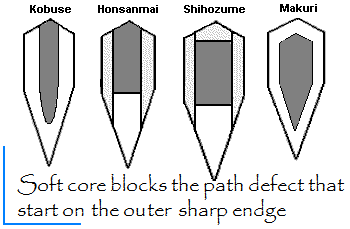








|
|
After the smith hammers
 all slag from the
tamahagane, he heats the hard, high-carbon steel and shapes it into a
long, U-shaped channel. He then hammers the tough, low-carbon steel,
which he has shaped so it will make a snug fit into the channel and
forges the two metals together. Both types of tamahagane are now exactly
where they need to be: the hard steel forms the sword's outer shell and
deadly blade, while the tough steel serves as the katana's core. This
perfect balance of properties is what made the katana the samurai's most
durable and prized weapon. all slag from the
tamahagane, he heats the hard, high-carbon steel and shapes it into a
long, U-shaped channel. He then hammers the tough, low-carbon steel,
which he has shaped so it will make a snug fit into the channel and
forges the two metals together. Both types of tamahagane are now exactly
where they need to be: the hard steel forms the sword's outer shell and
deadly blade, while the tough steel serves as the katana's core. This
perfect balance of properties is what made the katana the samurai's most
durable and prized weapon.
|
|

